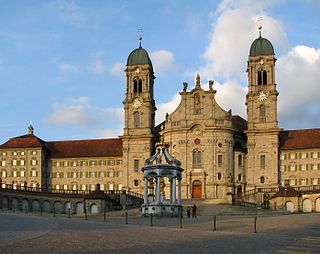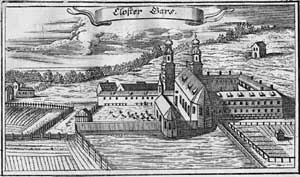
Michaelbeuern Abbey (German : Abtei Michaelbeuern) is a Benedictine monastery in Dorfbeuern near Salzburg in Austria.

Michaelbeuern Abbey (German : Abtei Michaelbeuern) is a Benedictine monastery in Dorfbeuern near Salzburg in Austria.
A monastic cell existed here as early as 736 or thereabouts, referred to in the Aachen Monastery Register("Klosterverzeichnis") in 817 as "Buria". After the Hungarian wars, reconstruction began in 977 with an endowment from Emperor Otto II. More times of crisis came upon the abbey with the fire of 1346, mismanagement of the prebendal income and the effects of the Reformation.

From the 17th century however Michaelbeuern began a long period of prosperity, which led to ambitious building works, for example the Baroque high altar of 1691 in the abbey church, by Meinrad Guggenbichler and Johann Michael Rottmayr. At this time more than twenty-five monks of Michaelbeuern gained their doctorates at the Benedictine University of Salzburg. The community also took on many pastoral responsibilities in the surrounding parishes. During the National Socialist period the monks were expelled, but returned after World War II. The abbey church, re-romanised, was re-dedicated in 1950.
From 1641 the abbey was a member of the Salzburg Congregation, which in 1930 was merged into the present Austrian Congregation of the Benedictine Confederation.
The abbey today is a thriving Benedictine community, well known as an educational and cultural centre. The abbey runs a school and owns different business like a farm, a district heating plant, a biogas plant and a participation in a brewery (Augustiner Bräu Kloster Mülln). The present abbot is Johannes Perkmann who was elected in 2006.

Melk Abbey is a Benedictine abbey above the town of Melk, Lower Austria, Austria, on a rocky outcrop overlooking the Danube river, adjoining the Wachau valley. The abbey contains the tomb of Saint Coloman of Stockerau and the remains of several members of the House of Babenberg, Austria's first ruling dynasty.

Einsiedeln Abbey is a Roman Catholic monastery administered by the Benedictine Order in the village of Einsiedeln, Switzerland. The abbey is dedicated to Our Lady of the Hermits, in recognition of Meinrad of Einsiedeln, a hermit Catholic saint. The monastery is not under the jurisdiction of a diocese or a bishop because it is a territorial abbey.

The Schottenstift, formally called Benediktinerabtei unserer Lieben Frau zu den Schotten, is a Catholic monastery founded in Vienna in 1155 when Henry II of Austria brought Irish monks to Vienna. The monks did not come directly from Ireland, but came instead from Scots Monastery in Regensburg, Germany. Since 1625, the abbey has been a member of the Austrian Congregation, now within the Benedictine Confederation.

Muri Abbey is a Benedictine monastery dedicated to Saint Martin of Tours. It flourished for over eight centuries at Muri, in the Canton of Aargau, near Zürich, Switzerland. It is currently established as Muri-Gries in South Tyrol and was formerly a part of the Austrian-Hungarian Empire.

Kremsmünster Abbey is a Benedictine monastery in Kremsmünster in Upper Austria.

Göttweig Abbey is a Benedictine monastery near Krems in Lower Austria. It was founded in 1083 by Altmann, Bishop of Passau.

Seckau Abbey is a Benedictine monastery and Co-Cathedral in Seckau in Styria, Austria.

Neresheim Abbey or the Abbey of Saints Ulrich and Afra, Neresheim is located above the town of Neresheim in Baden-Württemberg, southern Germany. It is now a Benedictine monastery and is part of the Beuronese Congregation.

Schäftlarn Abbey is a Benedictine monastery on the Isar in Schäftlarn, south of Munich in Bavaria, Germany.

Braunau in Rohr Abbey is a Benedictine monastery, formerly Rohr Abbey, a monastery of the Augustinian Canons, in Rohr in Niederbayern in the district of Kelheim in Bavaria, Germany.

Admont Abbey is a Benedictine monastery located on the Enns River in the town of Admont, Austria. The oldest remaining monastery in Styria, Admont Abbey contains the largest monastic library in the world as well as a long-established scientific collection. It is known for its Baroque architecture, art, and manuscripts.

St Peter's Abbey, or St Peter's Archabbey, is a Benedictine monastery and former cathedral in the Austrian city of Salzburg. It is considered one of the oldest monasteries in the German-speaking area, and in fact the oldest with a continuous history since its foundation in 696.

Altenburg Abbey is a Benedictine monastery in Altenburg, Lower Austria. It is situated about 30 kilometres (19 mi) to the north of Krems an der Donau in the Waldviertel. It was founded in 1144,by Countess Hildeburg of Poigen-Rebgau. Throughout its history it suffered numerous invasions and attacks, and was destroyed by the Swedes in 1645. Under Emperor Joseph II in 1793 the abbey was forbidden to accept new novices, but unlike many others in Austria it succeeded in remaining functional.

Mondsee Abbey was a Benedictine monastery in Mondsee in Upper Austria.

Saint Paul's Abbey in Lavanttal is a Benedictine monastery established in 1091 near the present-day market town of Sankt Paul im Lavanttal in the Austrian state of Carinthia. The premises centered on the Romanesque monastery church were largely rebuilt in a Baroque style in the 17th century.
The Austrian Congregation is a congregation of Benedictine monasteries situated in Austria, within the Benedictine Confederation.

Millstatt Abbey is a former monastery in Millstatt, Austria. Established by Benedictine monks about 1070, it ranks among the most important Romanesque buildings in the state of Carinthia. The Benedictines were succeeded by the knightly Order of Saint George in 1469 and the Society of Jesus in 1598.

The Wachau is an Austrian valley with a picturesque landscape formed by the Danube river. It is one of the most prominent tourist destinations of Lower Austria, located midway between the towns of Melk and Krems that also attracts "connoisseurs and epicureans" for its high-quality wines. It is 36 kilometres (22 mi) in length and was already settled in prehistoric times. A well-known place and tourist attraction is Dürnstein, where King Richard I of England was held captive by Leopold V, Duke of Austria. The architectural elegance of its ancient monasteries, castles and ruins combined with the urban architecture of its towns and villages, and the cultivation of vines as an important agricultural produce are the dominant features of the valley.

Gars Abbey is a monastery on the Inn River in Bavaria, Germany, in the town of Gars am Inn. It was founded in 768 and has been occupied by Benedictine monks, Augustinian Canons Regular, and most recently Redemptorists.